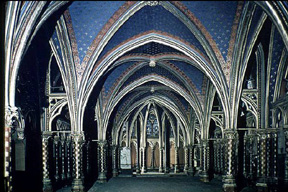
“If you do not rest upon the good foundation of nature,
you will labor with little honor and less profit."
Leonardo da Vinci

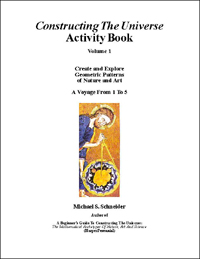
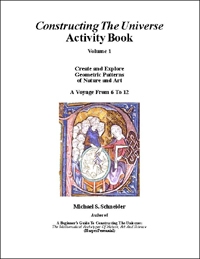
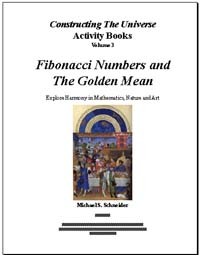


Natural Design and Sacred Art
The beautiful "Book Of Nature" speaks a timeless language of geometric patterns, written in an alphabet of simple shapes. Everything from atoms to galaxies, flowers, seashells and the human body are based on this small archetypal alphabet at the heart of all "sacred geometry" traditions. It served as the basis of the symbols of religions, mythologies and fairy tales, and underlies the designs of sacred art, crafts and architecture across cultures. Students will learn to recognize and read nature's symbolic language, and will construct many of these fundamental geometric patterns and use them to design original works of art.
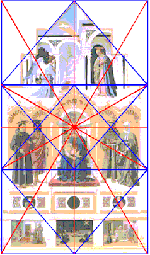 The Art of Root-Rectangles
The Art of Root-Rectangles
Architects, craftspeople and artists
from prehistory to the present have known about the classic proportions
which emerge from the simple turning of a compass. A knowledge
of the fundamental root-ratios allows a designer to harmonize
the overall form of a creation with its internal decoration. producing
a powerful coherence and aesthetic effect on viewers. These are
the proportions used in the designs of temples, monuments, sculpture,
painting, pottery, jewelry, furniture, royal seals and coins.
Topics include the philosophy of dynamic design and the elements
of “dynamic symmetry”, construction of the five basic
“root rectangles” and their rabatment. Participants
learn to evoke aesthetic guidelines and discover “hotspots”
towards which the viewer’s eye naturally gazes.
To see a geometric analysis of the Biblical illumination called "G*D The Geometer" click here.
The Art of Polygons

Another method designers have always used to create the classic
proportions occurs in the hidden use of regular
multi-sided polygons, the archetypal patterns we resonate with
whether we see them or not. Learn to recognize
the basic polygons and see many marvelous examples of their use
in art, crafts and architecture from ancient to
modern times.


To see how polygonal geometry was used to structure ancient
Chinese Pi discs, click here.
Worldwide Healing Art
Across many cultures, traditional healing included meditation
upon sacred art. Although expressed in different
ways, much sacred art has an underlying geometric framework guiding
the arrangement of images. When
constructed and used properly, these sacred designs can have a
healthy effect upon the viewer. This class will
examine geometric schemes of healing imagery from various traditions,
including Native American, Buddhist,
Hindu, and Christian, and show how to read the geometric message
underlying the obvious scene and symbols.
Sacred Windows
Light shines everywhere on Earth, but a sacred window transmits
and sanctifies light through its shapes,
proportions, colors and pictures. Learn to recognize and read
a window's underlying geometric symbolic message
in examples from various cultures. Bring a geometric compass to
learn how to replicate the construction which
yields a window or the facade of an entire cathedral.
To see an analysis of the north Rose Window of Chartres Cathedral, click here.
Principles of Sacred Architecture

Christian cathedral plan /
Hindu temple plan
In all traditions, sacred architecture is consecrated space representing
the entire cosmos in miniature, an imago mundi. The symbolic structure of sacred architecture
reenacts the local creation myth in which chaos is brought to
order. Sacred architecture is spiritual wisdom made visible, a
map of the Real which exists outside and within ourselves, a map
of our spiritual journey for gathering and integrating the fragmented
chaos of our lives into a coherent whole. Mandalas
become the floorplans of temples. This class will survey worldwide
sacred architecture traditions for their common underlying principles,
and how to read their geometric symbolism. [Note: Michael designed
the geometry which guides the sculptures at the north side of
the Portal
of Paradise, the main entrance to the Cathedral
of St. John the Divine in New York City.]
Design A Cathedral
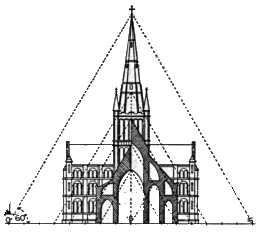
Cathedrals, like other sacred structures, were designed not by
whim, taste or fashion, but according to the timeless principles
of sacred architecture and the archetypal patterns which emerge
from number and geometry. Learn about the basic schemes at work
guiding cathedral floorplans and elevations. You are invited to
bring a geometric compass and straightedge to learn how to construct
and apply "root rectangles" and other basic patterns
used in traditional cathedral designs.
Design Sacred Pottery
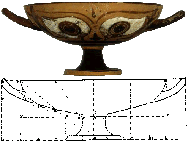
To many ancient cultures, geometry and number were considered
to be the purest expressions of "perfect truth", unchanging
and universal. By applying geometric harmony to the design of
sculpture, pottery
and architecture, cosmic truths are brought to Earth, imbuing
art with timeless beauty. This class will look through the eyes
of a Greek geometer to design sacred pottery using the proportions
made by simple movements of the compass. Based, in part, on the
work of Jay Hambidge. Bring a geometric compass, straightedge,
blank paper and colored pencils.

Design Egyptian Jewelry
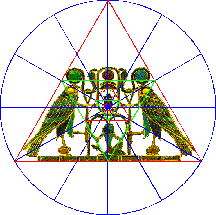
The ancient Egyptians are well known for
their beautiful sacred jewelry. But less known is how they used
an underlying symbolic geometry to express the power of their
works. Participants learn to recognize and replicate the geometric
frameworks used by the early Egyptians, and are encouraged to
create their own designs using this ancient system of proportion.
To see a geometric analysis of this necklace of the Egyptian Princess Sit-hathor-yunet, click here.
Golden Section Design
It has been long known that the same patterns of wholeness, growth, balance and beauty found in the designs of plants, animals and the environment are repackaged in the measures of the human body. The relationship which unifies all life is the Golden Mean, also known as the Divine Proportion, which Kepler called “a precious jewel” and with which the architect Le Corbusier derived his Modulor System. The Golden Section describes the harmony of part and whole, and is a key to designs from Greek vases to the UN Building. This workshop guides participants through the Golden Section as number relationship and geometric shapes, its appearances in nature’s architecture and ideal design of the human body, and its pleasing proportions seen in worldwide arts, crafts and architecture. Participants will be guided to use Golden Section Design in original creations.

Islamic Patterns and Escher's Art
M. C. Escher (1898-1972)
was a Dutch artist most recognized for spatial illusions, impossible
buildings, repeating geometric patterns (tessellations). He was
inspired by Islamic art, molecular crystallography and lace patterns.